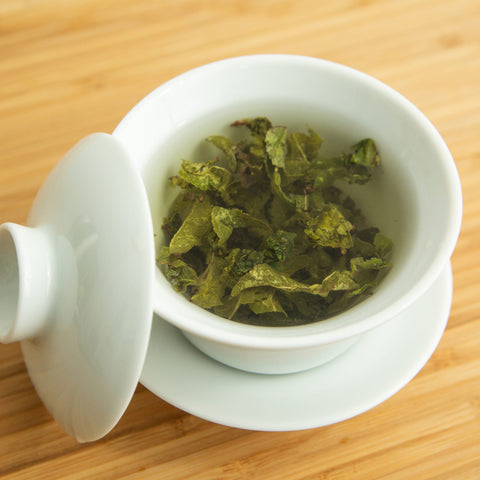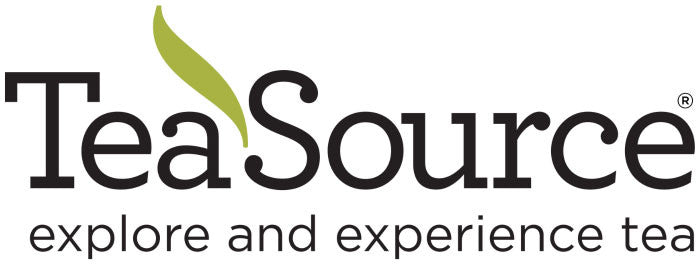What is Oolong Tea?
Wulong tea (more commonly spelled “oolong tea”) doesn’t have a fixed definition. It is typically described as “partially oxidized tea”, which is not wrong, but it’s not a complete picture. The oxidation level alone does not distinguish it as “wulong” tea. It’s the shared process of elaborate transformation (withering, shaking, pan-firing, rolling, drying, baking) that put these otherwise disparate group of teas under the same name.
Even the name does not have a fixed definition. Wulong translates as “black dragon” (which sounds cool to us), but it used to be referred to as “Qing Cha” (Cyan Tea). In China, the color cyan used to be more associated with “black” and often times the terms for these colors were used together (“wuqing”) which translates as “Bruising color” (the color of the leaves after bumping around during shaking). At the time when it originated in Fujian, all wulong had this dark color. The Anxi local language called it “wuliang cha” (translation: “black and good tea”), but that local pronunciation of “liang” sounded like “long”, meaning “Dragon.” The proper pinyin spelling is “wulong” tea, but it is more common in English to see it spelled “oolong tea” and they mean the same thing.
How is Wulong Tea Made?
 Tea leaves destined to become Tieguanyin
Tea leaves destined to become Tieguanyin
Each style of wulong tea is particular, so the below mentioned processing steps are generic, but to some degree all wulongs share them.
Withering
After the tea is picked, it is brought to its place of manufacture (which is close by) and spread out over large surfaces to wither. The purpose of withering is to allow moisture to evaporate, make the leaf more pliable (in order for it to not break during processing later), and to bring forth the aromatic elements from the leaves.
Shaking
The act of shaking is to make tiny “bruises” at the leaf’s edge where the cell wall is punctured and oxidation is allowed to happen (the Chinese use the term “fermentation” instead of “oxidation”). It also moves moisture from the stem and fibrous structures back into the leaf, bringing out more flavor and aromatic elements. The process of shaking and withering is alternated numerous times until the leaf is ready to move on to the next step.
Pan-fire
This step is more commonly referred to as “kill-green” and it stops/slows further oxidation (the initial step used when making green tea). How much oxidation that was allowed up to this point is dependent on the regional style and the tea makers choice. The time and temperature of kill-green have significant effects on the outcome of the tea and how it will be handled afterwards. This step is also important for locking in and preserving the aromatic character of the tea.
Rolling
How it is rolled depends very much on the style of tea. Rock wulong, Dan Cong and Bao Zhong are long strips of twisted leaves more evident of traditional hand-rolling. Anxi wulong and Taiwan Tung Ting are referred to as “semi-ball” style, which is a longer, repeated rolling/drying process that requires more equipment and patience. The purpose is to shape the leaf, reduce moisture, and draw out further flavor and aromatic elements (you can probably notice a pattern here).
Drying
This is the longer, lower-temperature process of removing the remaining moisture in the leaf down to a stable level. The goal is to remove any unwanted odors and bring forth desired aromas.
Roasting
All the above steps produce what they call mao cha (rough tea) which is also a finished product unto itself. Most wulong teas are defined by their roasting so this step is common to most styles (Bao Zhong is an exception). Roasting involves temperatures of 210-280°f for about 30 minutes to one-hour intervals with periods of rest in between.
Where is the Best Oolong Tea Made?
 Horse Head Rock in the Wuyi Mountains, Fujian
Horse Head Rock in the Wuyi Mountains, Fujian
There are four separate regions that produce commonly recognized wulong tea. Each has its own distinct style derived from local techniques and traditions. The four regions (and their most popular styles) are:
Wuyi Mountains, Fujian Province, China
Also known as “rock tea”, these teas have long, dark, twisted leaves that tend to be minerally, toasty, and citrusy.
Popular Styles:
Da Hong Pao (Translation: Big Red Robe)
Rou Gui
Shui Xian (Translation: Water Immortals)
Anxi County, Fujian Province, China
Famous for their tightly rolled, semi-ball style teas that bring out an unmatched depth of sweet/floral characteristics.
Popular Styles:
Tieguanyin (Translation: Iron Goddess of Mercy)
Huang Jin Gui
Guangdong Province, China:
 Dan Cong style oolong
Dan Cong style oolong
The “Dan Cong” teas of Phoenix Mountain are similar in appearance to rock tea from Wuyi, but give an extraordinary sweet, fruity, and fragrant character.
Taiwan:
Wulong teas from Taiwan are descendent from Anxi craft that migrated there in the late 19th century. But these styles have now matured into their own identities as Taiwanese tea. The popularity of Taiwanese Bao Zhong in China, which is distinctly green and floral, has had a recent influence on Anxi tea producers.
Popular Styles:
Bao Zhong (Translation: “Paper-wrapped tea” – also spelled Pouchong)
High Mountain Oolong (also known as Dong Ding (Translation: “Frozen Peak”) which can also be spelled “Tung Ting”)
Oriental Beauty (also called Bai Hao)
This is not a complete list by any measure. There are many more lesser-known styles not listed here.
Many teas labeled “oolong tea” from outside these regions usually refer to partially-oxidized tea and do not share other aspects of the wulong process. This does not mean they are bad teas, but they should be judged on their own individual merits.
Some wulong teas from outside the above-mentioned regions (Thailand is a good example) may bear a very close resemblance to these styles. But even though they may be using the same traditional wulong craft, the end result will be different due to the tea plant growing in a different climate and geography. Again, this doesn’t mean the tea is bad or of lesser quality, it means you can never replicate anything exactly and each tea should be judged on its own merits.
How to Prepare Wulong Tea
The common thread amongst all Chinese and Taiwan wulong tea varieties is that they are traditionally made using the gongfu style - large amounts of leaf in smaller steeping vessels (usually a gaiwan) for many short steeps. Though gongfu is largely unfamiliar in the west, we highly recommend it for wulong teas (and other Chinese tea types). It’s not to be taken too serious or ceremonial. It’s a lot of fun and anyone can do it.
Traditional Steeping method:
 Wulong steeping in a gaiwan
Wulong steeping in a gaiwan
Though the details and variants can be endless, it can be summarized as such: put 6-8 grams of tea into a 150ml gaiwan. Pour water that has been brought to a boil (or close to boil) over the leaves. Immediately decant into a pitcher and discard that steep. Then pour the hot water over the leaves again and steep for 10-20 seconds, decant, and serve. Repeat as many times as the leaves will yield satisfactory flavor. Always adjust to suit your tastes.
You can certainly prepare your wulong teas in a western style. You may even prefer it. But since this is not how they were intended to be prepared you may get very different results from doing it this way as opposed to the traditional method. Because the leaves of wulong teas are typically rolled or twisted up, they will typically not yield a full bodied cup like black tea, even if the leaf and liquor color are similar.
Western steeping method:
3-4 grams of dry tea leaves per 8-12 ounces of liquid. Steep for 3-5 minutes at water that has just been brought to a boil. It is frequently suggested that wulong teas be steeped at lower temperatures of around 190 degrees. But if you do not want to use a thermometer, wulong tea isn’t too fussy and we suggest don’t worry about it. Always adjust to suit your tastes.
How Much Caffeine is in Wulong Tea?
Since all tea comes from the Camellia sinensis plant, all tea has caffeine. There are three factors you control that determine how much caffeine ends up in your cup:
- How much leaf you use (more leaf equals more caffeine available to extract)
- How hot you steep it (the hotter the water, the more caffeine extracts into your cup)
- How long you steep it (the longer it steeps, the more caffeine is extracted from the leaf)
Many wulong teas are roasted which naturally reduces the caffeine levels available in them. However, many are not roasted at all, so the caffeine levels in those teas are not diminished. How much the roasting diminishes the caffeine in each particular tea cannot be known other than more roasting equals less caffeine.
 Da Hong Pao (aka Rock Oolong)
Da Hong Pao (aka Rock Oolong)
Health Benefits of Wulong Tea
Tea is one of the healthiest beverages in the world, especially as a preventative approach for long-term physical and mental health. TeaSource doesn’t make any claims about its teas as prescriptive solutions to any particular health issue since this is not our area of expertise.
Here are a couple articles to read if you are interested in learning more about the health benefits of tea:
From the NIH:
From “Medical News Today”:
https://www.medicalnewstoday.com/articles/269538#benefits
The health benefits of tea, though considerable, are not the foremost purpose for drinking it. Tea is for your enjoyment - in whatever way you choose to do that. And that enjoyment is good for you all by itself.

